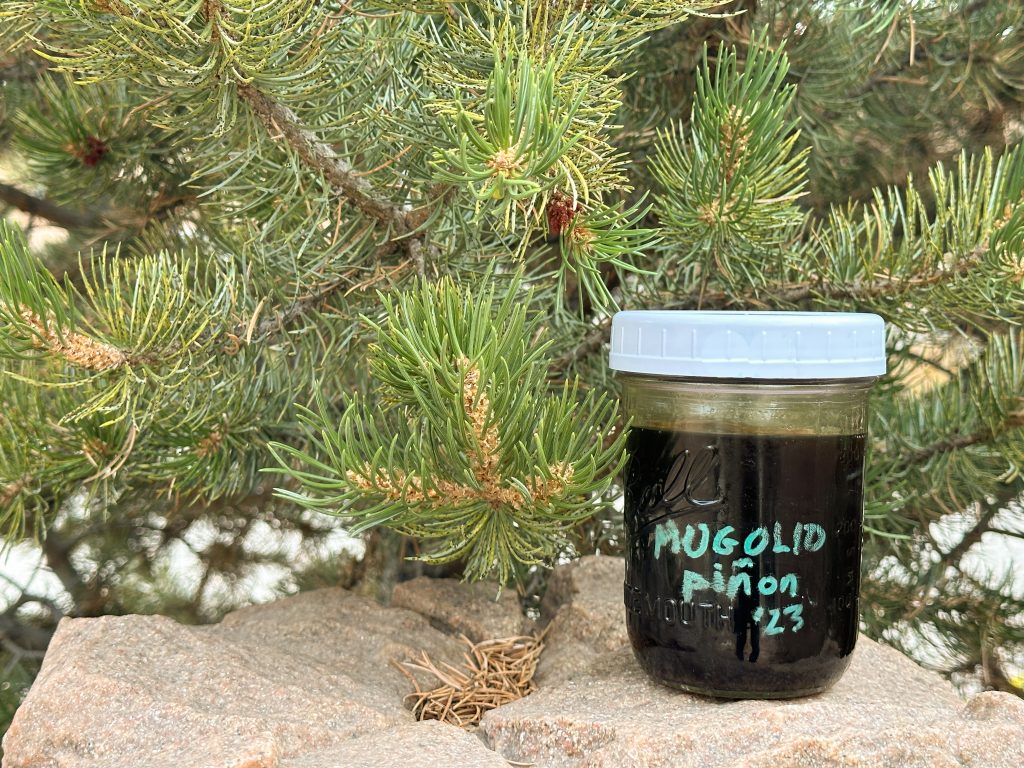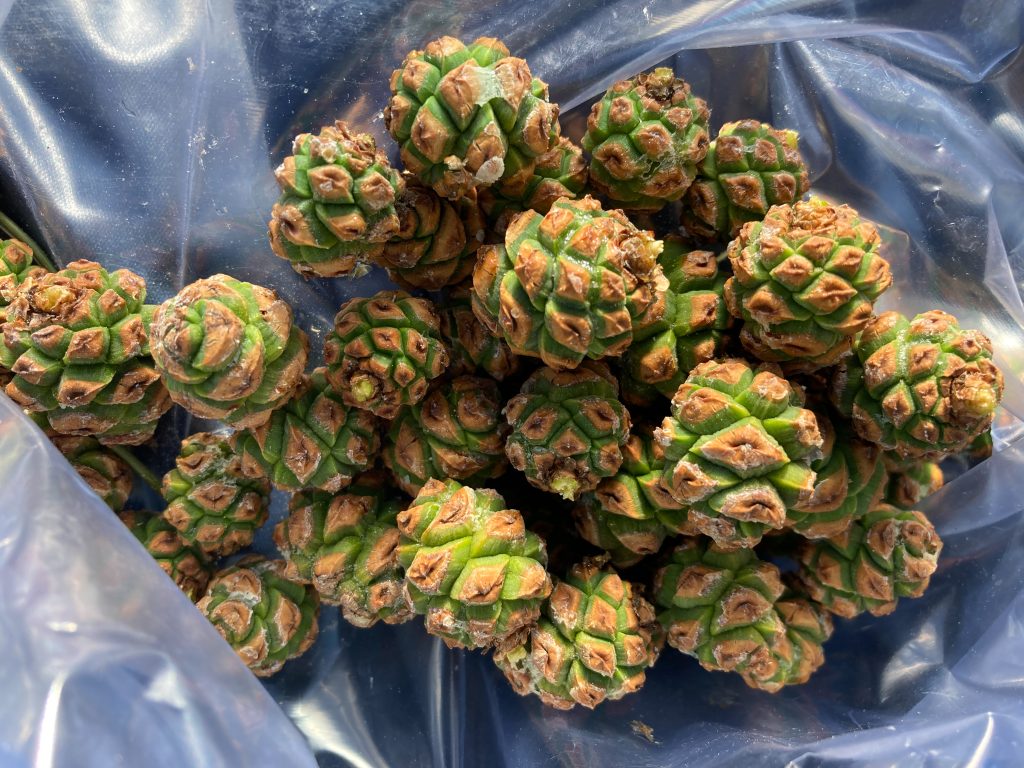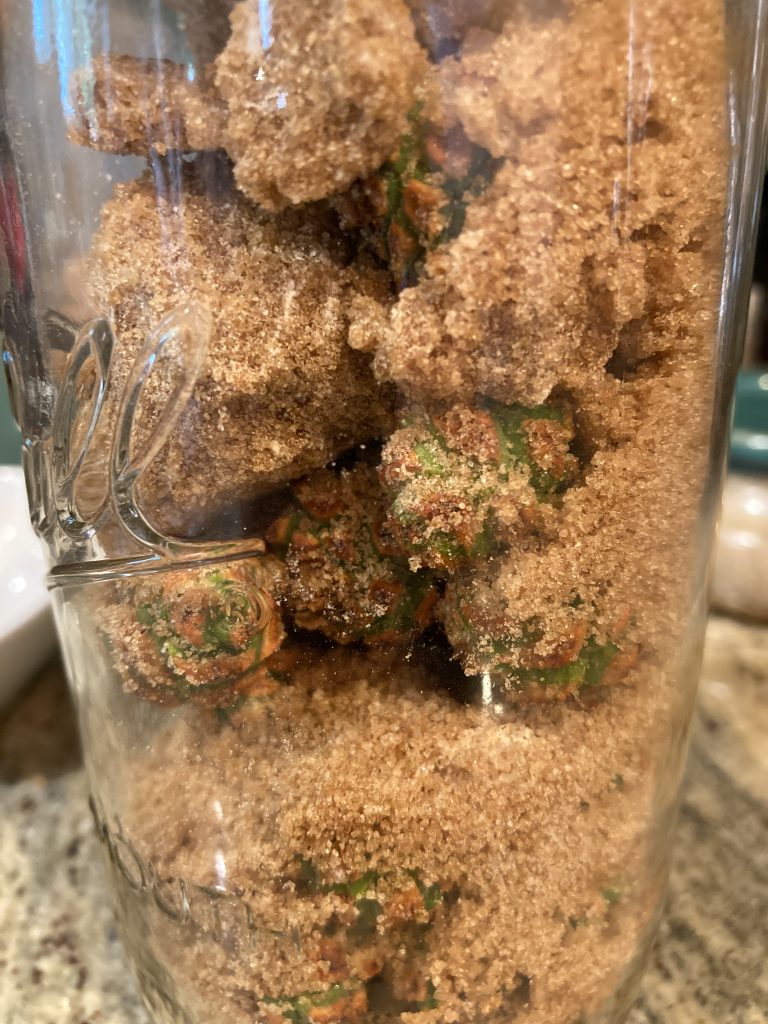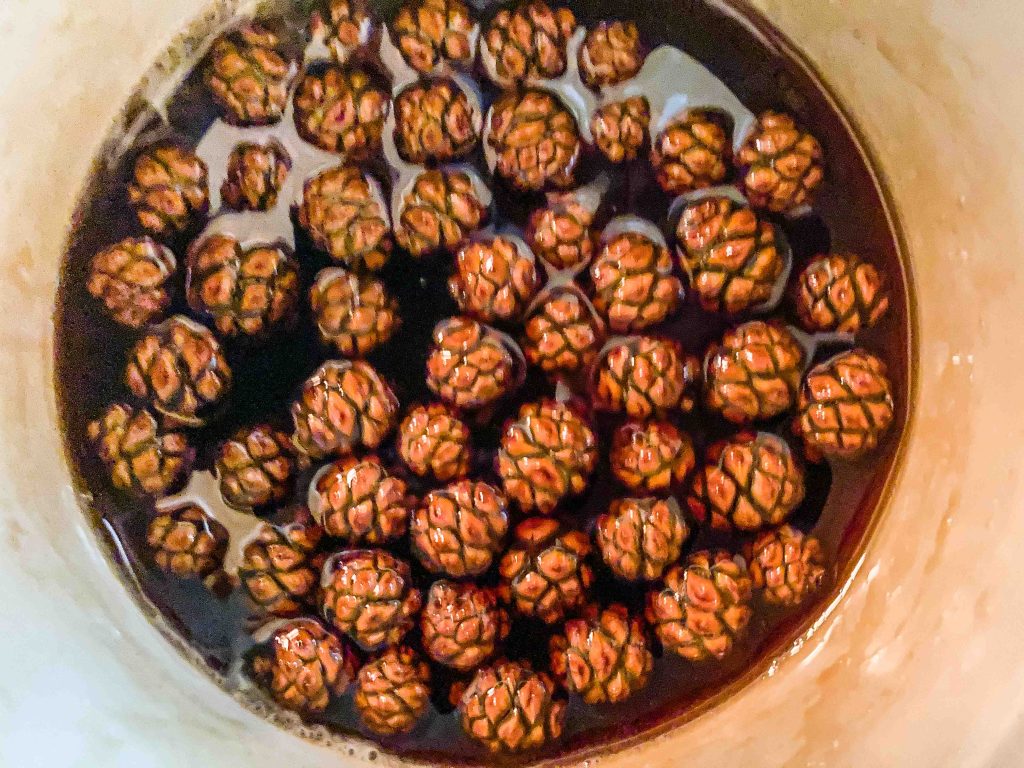
pinon pine cones at the perfect stage for mugolio
Ask most foragers what mugolio is and they’ll tell you it’s a syrup made by infusing unripe pine cones in sugar. But a quick google search brings up a New York Times article from 2011 that says it originated in the Italian alps and is made from the buds of the mugo pine.
Confused? So was I. After finding an online vendor who also describes it as being made from “pine cone buds,” I’ve decided to attribute the confusion to the language barrier. The syrup is sold by an Italian company and my best guess is that they meant immature pine cones (pine cones at the bud stage?). I’m also guessing the author of the article was a food writer, not a forager, someone who didn’t realize that the term “pine cone buds” is pretty confusing in English.
Originally made from Pinus mugo, you can use any immature pine cone, as well as the cones of several other conifers (fir, spruce, hemlock). Smaller cones seem to deliver more flavor, although I’ve also used larger cones and cut them up to expose more surface area for the infusion. The important thing is that the cones be green. A woody brown cone will not make a delicious syrup.
The recipe is ridiculously simple and almost foolproof. And the syrup is so delicious that once you taste it, you’ll find yourself gathering pine cone buds every spring.
WHAt you’ll need to make mugolio
WHAt you’ll DO to make mugolio
If you live where pinon pines grow, consider yourself lucky. These are my favorites, and make a syrup that tastes the way the southern Rockies smell on a hot summer day. Measure your pine cones and combine them with an equal volume of sugar in a glass jar. The choice of sugar is up to you. I prefer light brown sugar, but you can use white, turbinado, dark brown…basically whatever you have on hand. Each type will bring its own flavor to the party, with white sugar being the most neutral.
Shake or stir the two ingredients to combine, then put a lid on the jar and leave the jar on your counter where you can keep an eye on things. Some people set their jar out in the sun to speed the process, but I’m not giving the neighborhood raccoons a chance to mess with my mugolio.
While some mugolio recipes tell you the pine cones and sugar will begin to ferment within the first week or so, that has never been the case for me. If your mugolio DOES begin to ferment, you’ll want to catch it before it makes a mess on the countertop. If you see lots of bubbles filling up your jar, open the lid to let out the fermentation gases.
Over the next four weeks, you’ll notice the sugar begin to liquefy as the pine cones macerate in the sugar. Once I see a few inches of syrup at the bottom of the jar, I start inverting the jar every few days, sometimes opening the jar to give it a stir and encourage more liquefaction.
After a month your sugar should be fully liquified. (I find that the larger crystals of turbinado sugar take a little longer.) Use a rubber scraper to transfer the pine cones and liquid into a small saucepan and heat over medium heat. This will loosen up the syrup. If the syrup still feels too thick to pour easily, add a small amount of water, a few Tablespoons at a time, until the syrup is thin enough that you can easily separate the cones from the syrup by pouring through a strainer.
That’s it! The syrup can be refrigerated or water bath canned for long term storage. Canning may or may not be necessary, depending on how much water you add at the end, but I like the security of knowing it’s safe. Use mugolio in cocktails, drizzled over ice cream, or to take this wild pear crisp WAY over the top.




Thanks for sharing your first-hand experience!
I’ve been interested in mugolio for a while but I am confused by whether it’s actually a fermented product (or merely macerated and aged). Every post I’ve read about it seems confused or contradictory on this point. I would think that if there was active fermentation then the whole thing would eventually turn into alcohol or vinegar. My impression is that the sugar level is high enough that very little actual fermentation takes place, as you suggest. Does that sound correct?
I share your confusion! I have made mugolio multiple times and have never experienced fermentation, although I have produced some very delicious syrups. I believe that the high proportion of sugar inhibits fermentation, but I can’t explain why other people experience fermentation, unless they aren’t adding as much sugar as I do. And I can’t imagine that a fermented flavor would be preferred in this instance. Also, please forgive my late response. I actually answered you back in December but had a website crash and couldn’t remember which comment was waiting for my reply until I stumbled across it today.
I just discovered I’ve had an actual mugo pine shrub growing infront of my house as apart of our landscaping for the last 17 years… so I decided to try and make syrup with it and already on day 3 I burped it and it had a surprising amount of gas and smelled like fermentation / beer, I’m worried I’m accidentally making alcohol instead of syrup… I thought I added equal parts sugar and young cones (I eyeballed it) but maybe I need more sugar? Does the boiling at the end remove the alcohol if there is a content after a couple of weeks? In the meantime I’ll monitor it and burp it so it doesn’t build up too much gas and explode or something haha
Nice that you have a mugo so near by. I can’t tell you if your syrup is fermenting, since I’m not there to sniff and taste. But I can tell you that I don’t usually eyeball when I bake or can. The good news is that fermentation will give you a safe product, and if you boil it, that should remove some (if not all) of the alcohol. If I were you, I’d dip a finger in the liquid and see if it tastes alcoholic to you. And next time try measuring the ingredients and see if that changes things. As I mentioned in the post, others have reported fermentation starting, although that has never been my experience. I wonder now if it depends on what yeasts live on the pine cones where you forage. (Just thinking of this now.) A friend in WI regularly has his mugolio ferment, while my experience in NM is entirely different. I realize my climate is much more arid than most, but I can’t say if this makes a difference of not. All I can say is yes, you can boil off the alcohol if there is any, and good, don’t let the container explode!
I have a blue spruce and the pine cones are brown and did I wait too long to retrieve the cones to make the syrup I am so wanting to make this thanks so much
Hi Donna, it depends on whether they are flexible or dry. Some spruce cones are brown (color) even when they’re green (immature)! Are your cones flexible and easy to cut through? If so, they are immature enough to be used. If they’re dry, difficult to cut with a knife, and the scales are already falling off, then they’re too mature. good luck!
Hi Ellen – totally love this Mugolino idea! Also appreciate that you suggest various sugars to experiment with.
A clarification question:
Recipe ingredients say to use “equal parts” of cones and sugar, not defining “equal” as weight or volume.
Narrative instructions read “equal parts by volume”.
Measuring by volume seems inherently inaccurate since one part of cones by volume measure has large voids between cones, while the one part of sugar volume has more or less extremely small voids between crystals.
Is there a relative weight ratio for the ingredients that you have found?
Or I am I overthinking it, and should just grab a bucket of cones and a bucket of sugar and have done with it?
I appreciate your considering the question!
– Fan of Foraged Flavor
I do use volume for this, and you’re absolutely right, there are large voids between the cones. But mugolio is one of those things that is both forgiving and flexible. The size, species, and ripeness of your cones will effect the flavor, as will the type of sugar you use. This year (for the first time), I’m adding more sugar to the jar as the initial amount dissolves into syrup. I’m adding just a little at a time, because I don’t want to dilute the wonderful pine flavor and scent. We’ll see how that works. I think if this is something you need to be able to repeat with precision each time you make it, you can weigh your ingredients. But if you simply want something delicious and don’t mind the surprises that come with experimentation, then play with the amounts as you see fit. Just as the surprises of foraging are part of what makes it joyful, so are the surprises of the food we make with foraged flavors. At least for me.
I came here looking for pointers or connects on when my concoction would stop being gassy. I found another recipe that suggested burping daily for the first week then weekly there after… I made 2 jars. The one with just eastern hemlock is less gassy than the jar with a mix of EH, blue spruce, and a third conifer I have yet to identify (I was too excited to find comes I could reach to take a picture of the pine, I’ll go back and ID before a taste test). Both smell deliciously piney and citrusy. May do a taste test before the month. Most of the raw sugar dissolved over first week and I added more to “fill the gaps”. The jar with the 3 pine cone mix easily burps 2x a day (morning & night) and you can see bubbles moving. Maybe I didn’t use enough sugar, definitely a subscriber of the eyeball-club.
Sorry to disappoint you! As you probably know, I’ve never needed to burp any of my mugolios. All have been delicious, but none have fermented, which may be because the high proportion of sugar inhibits fermentation. A chemist friend suggested that what some people blieve is fermentation is actually off-gassing from the cones themselves, but I haven’t researched this myself. That being said, if the lid on your jar starts to bow outward, it’s a good idea to burp it!
I started my mugolio about 3 weeks ago. Found some green pine cones at the top of a small mountain. I feel like I need to add more sugar. Is it bad to open now and add more sugar?
Thanks,
Tom
Hi Tom, I’m curious as to why you feel you should add more sugar? Did you combine equal parts (by volume) of the sugar and pine cones? If so, I’d say you’re fine. Once, I felt as you did and added more sugar and the end result was ok, but it also weakened the flavor. You won’t hurt anything by adding more, but unless you used less than equal volume (sugar/cones), I wouldn’t rush into that. Maybe stick your finger in the sugar/syrup and see what the flavor is like. If it pleases you, don’t add more sugar. If it’s weak, def don’t add more sugar. If it’s too strong for your liking, add more sugar. Good luck! (Now I’m going to check mine…it’s been brewing since mid-July!)
Thanks for the quick reply. What syrup had settled was too intensely flavored so I added more brown sugar and I will leave it alone for a while. Will report back in 2025!
I started my mugolio on Aug 1 with pinon pine cones. They were green but large and covered with resin. I cut in halves and quarters. Tried to follow instructions/proportions etc meticulously. I made 2 quart jars. Both now have about 2″ of syrup but both still have 2″ of sugar as well and seem to be stalled at that point. Shaking and stirring doesn’t seem to help. Any suggestions or should I just decant the syrup that is there and go with that?
Hi Donna, this happens sometimes, but it isn’t a problem. The last step of the recipe says to heat the mugolio over medium heat, stirring to dissolve the rest of the sugar, then you strain off the cones. Take another look at the recipe for instructions on what to do if the syrup is still too thick to strain easily.
Thank you for the prompt reply. I’m wondering what might happen if I added a TB or so of water to the half-syrup, half-sugar mix that is in the jars now. Maybe add distilled water to lessen any pollutants? And maybe give it anotrher month? I dont think the current amount of syrup would incorporate the nearly equal amount of sugar still left. How about putting the quarts in oven with pilot only….might the increased temperatures get things going again?
You could certainly try adding water now, instead of at the end. I wouldn’t worry about using distilled vs. regular tap. If your tap water is safe to drink, it’ll be safe for the mugolio. Good luck and lmk how it turns out.
Does anyone have experience with Pygmy Cypress Cones? From my research I understand almost all pine cones are used to make Mugolio?
Is there any specific cones that are toxic?
Any pine cone is safe to use for mugolio, but there are many other evergreens that produce cones and not all are safe. I suggest googling the botanical name for pygmy cypress and starting your research there.
I made Mugolio this year using several different types of pine cones from various trees.around us. I don’t know what I am doing wrong, but I made 3 separate batches and all of them crystalized in the bottles.nI followed the directions I thought. Any suggestions would be most appreciated.
I’ve read about this happening to others, but have never experienced it myself. Here are my best guesses/advice: 1) Check the measurements of your material, i.e. ratio of cones to sugar. I don’t know what kind of cones you used, but large cones leave big air spaces which could lead you to use too much sugar. Try chopping your cones into smaller pieces (about an inch in diameter) or measure by weight rather than volume. 2) Transfer your crystalized mugolio to a saucepan and heat it up, adding just a smidge (depending on how big your batch is, maybe 1 tsp – 1 TBS of water and the same amount of corn syrup. That may prevent re-crystallization. Good luck!